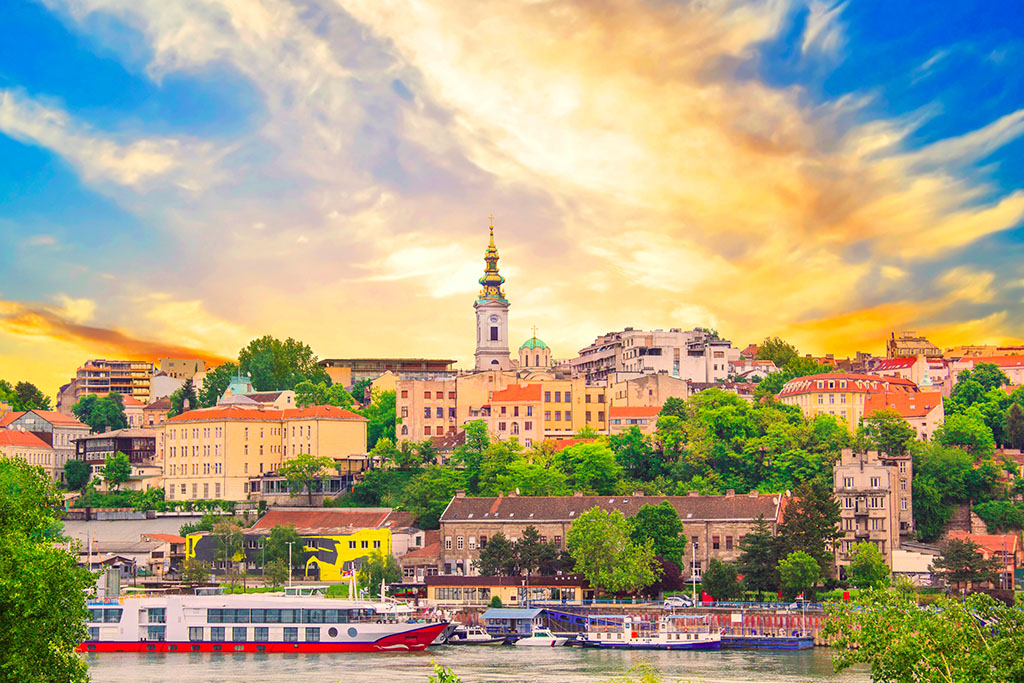
Belgrade, the capital of Serbia, is a dynamic city where history meets modernity. We have presented a plan for two days in the city, but you can choose to cherry-pick your own highlights based on the time you have available.
Day 1: History and Cultural Landmarks
Start your trip at Belgrade Fortress, one of the city’s most iconic landmarks. The fortress sits on a hill overlooking the confluence of the Danube and Sava Rivers. The fortress is not just a single building but a vast complex with centuries of history. You can explore its ramparts, gates, and towers while enjoying sweeping views of the rivers and the city. Within the fortress, take some time to visit the Military Museum, which provides a detailed overview of Serbia’s military history, and the Ružica Church, a quaint chapel adorned with chandeliers made of weaponry.
From the perspective of our tour focus Suleiman the Magnificent played a pivotal role in Belgrade’s history during his reign. In 1521, he captured the city from Hungary, marking a significant victory for the Ottoman Empire. Belgrade became a key Ottoman stronghold and gateway to Central Europe, integrating into the empire for nearly 350 years. Suleiman fortified the Belgrade Fortress and expanded the city’s strategic importance, establishing it as a centre of military and administrative power. The Ottoman influence transformed Belgrade’s architecture, introducing mosques, baths, and markets, while the city’s multicultural character flourished under Ottoman rule, blending Eastern and Western influences.
Surrounding the fortress is Kalemegdan Park, a peaceful green space where locals gather to relax. It’s perfect for a leisurely walk, and you might stumble upon outdoor exhibits, sculptures, or street musicians.
After the fortress, head to Republic Square, the heart of Belgrade’s historic district. The square is surrounded by key landmarks like the National Museum and the National Theatre. You can stop by the National Museum for a look at its vast collection of Serbian and international art, including works by Picasso and Monet, or just take in the lively atmosphere of the square.
From Republic Square, stroll down Knez Mihailova Street, Belgrade’s main pedestrian thoroughfare. This lively street has elegant buildings, shops, cafes, and restaurants. It’s a great spot to take in the local scene, enjoy some people-watching, or stop for a coffee break.
In the evening, head to Skadarlija, Belgrade’s bohemian quarter. Often compared to Montmartre in Paris, this cobblestone street is known for its traditional Serbian restaurants, live music, and artistic vibe. It’s the perfect place to enjoy a traditional Serbian dinner, accompanied by local musicians playing folk music. Don’t forget to try classic Serbian dishes like ćevapi (grilled minced meat) and rakija (a potent fruit brandy).
Day 2: Exploring Local Culture and Modern Belgrade
Begin your second day with a visit to the majestic St. Sava Temple, one of the largest Orthodox churches in the world. The church is still under construction, but its vast size and stunning white marble exterior are already impressive. Inside, the dome and frescoes are breathtaking, offering insight into Serbia’s religious and cultural heritage.
Afterward, visit the Nikola Tesla Museum, which is dedicated to the life and work of one of the greatest inventors of all time. The museum houses Tesla’s personal belongings, his original documents, and exhibits on his groundbreaking inventions. It’s a must-see for anyone interested in science and technology.
In the afternoon, venture to Zemun, a charming neighbourhood that feels like a small town within Belgrade. Located along the Danube River, Zemun is known for its Austro-Hungarian architecture, narrow streets, and riverside cafes. Climb the Gardos Tower for panoramic views of the area and the river, then take a leisurely walk along the Zemun Quay, where you can relax by the water or enjoy lunch at one of the floating restaurants.
For a relaxing end to your trip, visit Ada Ciganlija, an island in the Sava River that has been transformed into a recreational oasis. Known as “Belgrade’s Sea,” Ada has a lake, beaches, walking and cycling paths, and cafes. It’s a popular spot for locals to unwind, and you can swim, rent a bike, or simply enjoy the natural scenery.
Finish your day in Savamala, a trendy neighbourhood known for its vibrant nightlife and street art. This district has transformed from an industrial area to a hub of creativity, with galleries, bars, and nightclubs lining its streets. It’s a great place to experience Belgrade’s energetic nightlife, whether you’re looking for live music, cocktails, or dancing.
Additional Tips:
Public Transport: Belgrade has a reliable bus, tram, and trolley system, though many of the central sights are walkable.
Food: Serbian cuisine is hearty and meat-centric, so make sure to try local specialties like pljeskavica (Serbian burger) and kajmak (a creamy dairy product).
In two days, you’ll experience Belgrade’s mix of history, culture, and modern charm.